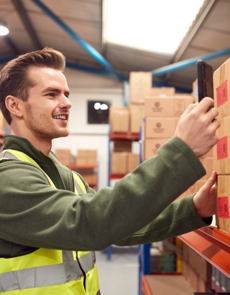Advantages and Disadvantages of Warehouse Management Systems
Warehouse management software can be useful to implement as your own warehouse operations grow and order numbers or client numbers increase. As you need to optimise your warehouse space and operations increase – technology, software and systems could be the solution you're looking for.
In this article, we will explore the advantages and disadvantages of Warehouse Management Systems to aid you in your decision making.
What is a Warehouse Management System?
A Warehouse Management System (WMS) is a tool to manage your warehouse operations, such as tracking inventory levels, orders, deliveries and storage of a warehouse.
No matter your warehouse size, a WMS can help you use your space in the most efficient way, keep track of item locations for put aways and picking, maintaining stock levels and help your staff work effectively by generating batch pick lists and automatically generating shipping labels.
Benefits of Warehouse Management Systems
The following are some of the advantages of a warehouse management system you can expect to see when you implement a WMS:
1. Improved Inventory System Picking Accuracy
Inaccuracies in your inventory management can lead to low customer satisfaction, high product returns and loss of revenue.
By using a Warehouse Management System, you can implement processes to improve accuracy of your inventory buying by ensuring your stock levels are tracked to avoid over or under stocking your warehouse, inventory storage by tracking the locations of all items from put away, and picking and packing by streamlining the process from office to warehouse floor.
2. Improved Customer Service
A positive customer experience will build brand loyalty and customer satisfaction, so meeting, or even exceeding their expectations is significant. You may be communicating with your customers manually, or inputting data such as tracking numbers from one system to another that could lead to missed or incorrect communications.
A WMS can help you manage customers expectations and ensure they enjoy a seamless experience with you. The system can automate important touch points such as order confirmations and shipping updates with the option for personalisation, to keep the customer informed of their order status and make them feel appreciated and valued.
3. Reduced Stock Inventory Costs
To run an efficient warehouse, you will want to have the right stock levels at the right time, also known as stock control. It’s easy to think you need to have high stock levels at all times, however that can result in over-ordering and inefficient storage of goods that are not being ordered.
An advantage of using a WMS is that you can track stock levels without undertaking timely stock takes. If your WMS has reporting capabilities, you can also begin to see trends in orders and stock delivery time scales. This allows you to plan ahead and ensure you have the correct stock levels at all times, especially during your seasonal peaks, and avoid over or under-stocking – ultimately saving you money by reducing storage costs and increasing supply chain visibility.
4. Reduce Time Spent Managing
Without a centralised Warehouse Management System, you are likely spending a lot of your time managing everything around you, from accepting orders and stock deliveries to creating pick lists and instructing your warehouse staff.
A WMS system can help reduce the amount of manual intervention needed day-to-day. Orders can be automatically accepted and allocated, and further automation within the system can batch orders for picking. Additional functionality such as a warehouse map can also speed up stock delivery and put aways by having a clear understanding of where inventory should be placed.
5. Increase Speed of Orders
Customers are expecting faster delivery from point-of-sale with 24 and 48 hour delivery options offered as standard from many retailers.
A Warehouse Management System can help speed up fulfilment processes by offering automation of activities such as shipping label generation and prioritised pick lists which go directly to the picker/packers work schedule via technology such as mobile barcode scanners.
Disadvantages of Warehouse Management Systems
It’s important to weigh up both the pros and cons before deciding whether a new software or system is right for your business. The following are some of the disadvantages you may wish to consider:
1. Set-up Costs
The initial cost of a new system or software can be an investment. While it can seem like a risk and a large expense, the time and money savings you make within your first year should offset some or all of your initial outlay.
You can read more about the pricing of a Warehouse Management System in our pricing guide.
2. System Set-up
Another part of implementing a new WMS system is the manual aspect of setting it up. Your business is likely to currently consist of multiple existing systems and it will take some time to connect them to your new WMS system.
Core business functions like your accounting software and marketplaces are crucial integrations to get set up correctly. Additionally, your WMS can offer enhanced functionality such as courier rules based on size or weight to get the best rates for shipments.
3. Data Maintenance
Once your data sources, integrations and systems are all linked to your Warehouse Management Software, the task of data management is unfortunately not entirely automated. You will likely still need to spend some time ensuring your data is transferring correctly and that all of your integrations remain connected. While this will not be a daily task, it will take some time out of a month.
4. Potential Single Point of Failure
A concern many businesses we speak to have is that by combining all of your systems into one Warehouse Management System, you have a single point of failure for your entire warehouse operations. This is a legitimate concern and could result in having no access to data if the system goes down and halting all of your activity.
While this is a possibility, a key thing to consider if this is a concern, is the reliability of the WMS you choose alongside the access to support the WMS provides to get you back up and running as soon as possible.
Next Steps
If you’re looking to optimise your warehouse and would like to begin looking at how to choose the right Warehouse Management System for your warehouse, you can read our 5 top tips for choosing the best warehouse management system.
Alternatively, if you’re ready to see Mintsoft’s Warehouse Management Software System in action, you can book a demo with one of our product experts.














